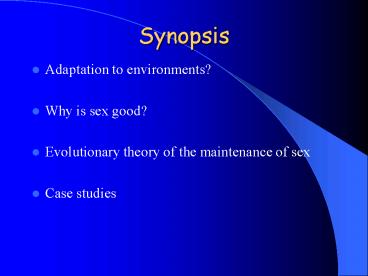Synopsis - PowerPoint PPT Presentation
1 / 30
Title: Synopsis
1
Synopsis
- Adaptation to environments?
- Why is sex good?
- Evolutionary theory of the maintenance of sex
- Case studies
2
Adaptation to physical biological environments
- Physical and biological environments differ
radically in PREDICTABILITY - Physical environment - reln. between conditions
constant between generations - Biological environment - reln. between conditions
can vary WITHIN a generation
3
The cost of sex
- 2-fold cost of meiosis
- useless half of the popn. males
- female dilutes her gene pool
- mating
- cost of ornamentation
- mating displays etc.
4
Why is sex good?
- Muller's ratchet
- accumulation of deleterious alleles
- hitch-hiking
- breaks up disadvantageous combinations and
preserves best - Group seln.
- ultimate in altruism - unlikely unless close
relatives
5
Why is sex good (2)
- Balance theory - states that there is an
advantage to simultaneous sexual and asexual
reproduction because of environmental demands. - little support as most plants/animals serially
sexual/asexual
6
The Biological Environment
- Capricious - can change within a generation
- How can long lived organisms cope with such
challenges? - Sex! - produces unpredictable genetic
combinations each generation - The Red Queen Hypothesis
7
Freshwater bryozoan Cristatella mucedo
Myxozoan parasiteTetracapsula bryozoides
J.R. Freeland, L.R. Noble B. Okamura (2000) J.
Evol. Biol. 13 383-395
8
Cristatella mucedo - population structure
- Popns. linked by dispersal geneflow
- Repeated localized extinctions recolonizations
- Balance by drift gene flow - levels of popn.
differentiation enhanced/diminished - Affect on popn. genetic structure?
9
POPULATION STRUCTURING
Forces reducing differentiation ? Forces
increasing differentiation
10
Reproduction in C. mucedo
- Inhabits discrete lakes ponds
- sex infrequent
- disperses via asexual propagules (statoblasts)
- Predominatly asexual reproduction, budding,
colony growth fission, statoblast prodn.
11
Reproduction in C. mucedo
- Inhabits discrete lakes ponds
- sex infrequent
- disperses via asexual propagules (statoblasts)
- Predominatly asexual reproduction, budding,
colony growth fission, statoblast prodn.
12
Dispersal/gene flow
- Some sexual repdn. beginning of season
- Larvae give limited within-site dispersal
- Asexual statoblasts highly resistant, survive
winter - gas-filled cells allow buoyancy and
within-site dispersal - hooks allow long distance
dispersal via animals - Survive desiccation and passage through digestive
tract
13
Genetic strategy?
- Facultatively sexual animals produce
overwintering propagules via sex - Asexual propagules unusual - but can be produced
in abundance - Gives greater chance of passive dispersal and
survival max. chance of (re)colonization - Dispersal potential metapopulation
14
Molecular Ecology - bryozoan systems
sexual/asexual
host-parasite - Red Queen, host escapes by
evolution of resistance
- budding, self/outcross
- good dispersal
- few widespread clones
- fugitive lifestyle
- novel myxozoan
15
The parasite -Tetracapsula bryozoides
- Myxozoan thought related to cnidarians now
not sure - Kills all colonies it infects heavy infections
wipe out bryozoan popns. - Agent of Proliferative Kidney Disease in trout
(PKD)
16
Summary
- Persistence of high levels of clonality
- Clones highly related
- Clones varied in abundance
- Commonest not disproportionately infected
- No evidence for Red Queen
- How does C. mucedo survive?
17
The Great Escape
- Metapopulation structure
- evidence of sub-division and gene flow
- high diversity of clones dispersal
- Asexual statoblasts
- produced at end of season - vs. sexual
overwintering propagules
18
(No Transcript)
19
Favouring Asexuality
- Asexual repd. favoured when
- metapopulation structure
- successful dispersal
- Big fitness benefits for single clone
- e.g. Loriston Loch
- Risk of extinction reduced by broad temporal and
spatial spread
20
Synopsis
- Adaptation to environments?
- Why is sex good?
- Evolutionary theory of the maintenance of sex
- Red Queen running to stay ahead of parasites
- Speciation separating good genes from bad
- Case studies
21
Arionid slugs the nematodePhasmarhabditis
hermaphrodita
22
Molecular Ecology - slug bryozoan systems.
sexual/asexual
host-parasite - Red Queen, host escapes by
evolution of resistance
- facultative selfers
- poor dispersal
- species complexes
- genesis of taxa
- nematodes
- budding, self/outcross
- good dispersal
- few widespread clones
- fugitive lifestyle
- novel myxozoan
23
The Large Arions - are they really difficult to
identify?
- Arion ater ater - black?
- Yes - but also red, yellow, white
- A. ater rufus - orange?
- Yes - but also black and yellow
- A. lusitanicus - Lusitanian distribution?
- No! - anything but, prefers drier eastern sites
- A. flagellus - a distinct flagellum?
- No! - a matter of taxonomic precedence
A. ater
A.
lusitanicus
Yes!!
24
How did this diversity arise?
- Clues from distributions of selfing vs
outcrossing taxa? - Respective levels of genetic polymorphism?
- Anatomical similarity?
- Legacy of an Ice Age?
25
Selfers vs. Outcrossers
- Selfers Outcrossers
Few clutches Eggs few large High quality
offspring Low juvenile mortality Less repd.
investment Often biennial Short protandry Late
maturation High altitudes/latitudes
Many clutches Eggs many small Low quality
offspring Higher juvenile mortality More repd.
investment Annuals Long protandry Early
maturation Low altitudes/latitudes
26
Distribution of selfers vs outcrossers
- 93 of parthenogenic and selfing taxa found at
higher altitudes and latitudes than closely
related outcrossing taxa. - Biologically simple vs biologically complex
environments.
27
But.?
- Selfers also common in the tropics!
- Surely a selfing species can easily be overcome
by parasites/pathogens in the evolutionary game
of the Red Queen?
28
Avoidance via speciation
- Speciation very rapid and many species complexes
- Each species represent markedly different genetic
entities - Method of isolating gene complexes
- more difficult for parasites to invade than one
species
29
Parapatric species
- Have adjacent but non-overlapping distributions.
- Reproductive barriers? sub species
- Rapid speciation in the face of environmental
change?
30
Conclusions
- Biological environment a driving force in
evolution. - Promotes
- Rapid genetic change
- Speciation
- Facultative self-fertilization
- Fugitives - movers
- Species - shakers































